
Roger's History
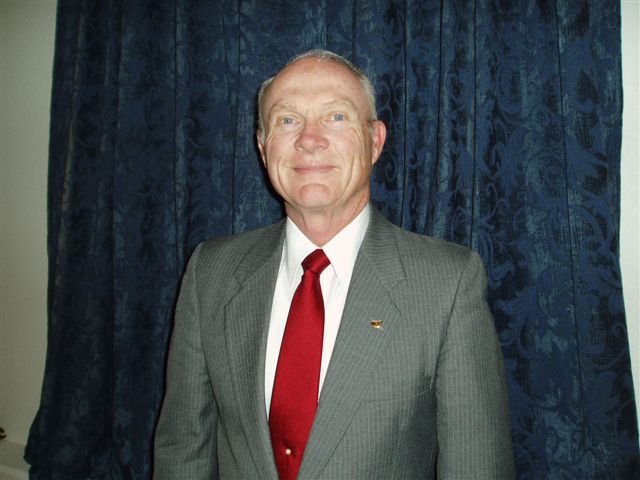
Before USAFA
I came to USAFA in June along with everyone else after being told in May that I was not qualified. I had about two weeks to decide to accept a qualified alternate appointment. Turns out the primary appointee didn't graduate with us. I came from being a relatively large fish, at least academically, in a small 60 kid pond in Western Nebraska. At my high school 50 year reunion I received a backhanded compliment from one of my old nemeses who referred to my Viet Nam tours saying- “of all the people in the class we sure didn't expect you to be the one doing this”.My dad was a farmer and rancher with a college degree and experience as a design engineer in World War II. He just got tired of working for other folks. Maybe this helps explain my meandering and non-textbook approach to my careers in the AF and since.
USAFA Cadet Days
It didn't take long to realize my small town education was not enough to keep up with everyone else in the class. After some ego shattering I finally came to grips with this and managed to stay in the good graces of the Dean. The Commandant--not so much. It wasn't so much getting in trouble--I don't think I got any demerits until senior year when I “rebelled” by displaying non standard towels!! It took me years after graduation to realize the “system” wanted me to stick my neck out, but I was usually invisible. This probably explains why the high points of my cadet military rank were as Athletic Officer (!!!) and Academic Officer as a Cadet First Lieutenant. I should have realized the AF was telling me something. I started down my strange career path by standing up in one of the lecture halls during our assignment choice process and volunteering for helicopter training at Randolph AFB while T-38s at Williams was still open. Friends questioned my sanity then and later but it was the right choice for me.Flying Days
Class 66AH convened at Randolph in July 64 with 8 zoomies and one First Lieutenant ROTC grad as class commander to keep us in line. We learned to fly on T-28s (for guys who don't remember, these had exhausts and were really hard to start) along with Vietnamese Air Force students. I got so tired of grilled onion and spam sandwiches on my hot plate in the BOQ that I convinced my lovely bride to be, Linda Ostlin, to move up our wedding date from pilot training graduation. This was probably the best move I ever made. We were married in Denver between T-28 training and helicopters at Stead AFB. Our honeymoon consisted of two days on the road to Nevada.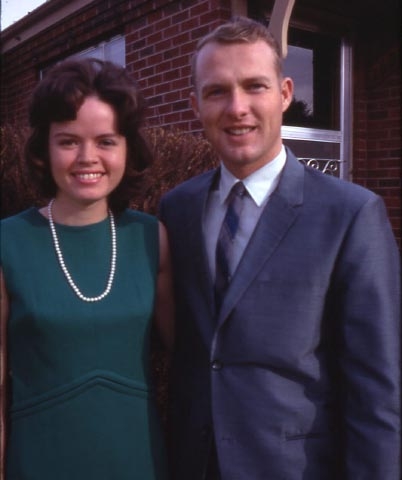 Helicopter training was uneventful and since Survival training was also at Stead our class was able to look over the hill from the “POW Compound” and know our wives were there.
Helicopter training was uneventful and since Survival training was also at Stead our class was able to look over the hill from the “POW Compound” and know our wives were there.
My first assignment was in August 65 to Tyndall AFB flying CH3s to pick up the drones the ADC guys liked to shoot down. The only problem was that in September the Air Force decided to create a helicopter squadron in Vietnam so they took all our aircraft. Since the official position was that we would “win the war” in 6 months and only volunteers were going to SEA, we were told to volunteer. The same squadron party which welcomed us to Tyndall was our farewell party.
The 20th Helicopter Squadron was formed at Hurlburt Field in November 65 and we shipped over in December. Max Manning and I were 2nd Lieutenants when we left Travis and 1st Lieutenants when we got to Saigon. We were the two junior guys with 40 other much more experienced pilots- remember we were going to win the war in 6 months. We hauled ammunition, Army howitzers, TACAN parts (remember the Lima sites) and downed O-1 spotter planes. We recovered the O-1s when we could because the radios in them were more valuable than the airframes. One O-1 tried to fly up in to us while we carried it and ended up in the Mekong River. Another one came back to base and was flying the next day. I had to use the rotors, gently, to hover my way in through trees to pick up one east of Thailand. Night missions were interesting, especially when landing our load in rice paddies between branches of Uncle Ho's trail. It was tricky if the bad guys knew we were coming as we had no armor plating. Punji sticks could penetrate the fuel tanks if we weren't careful.
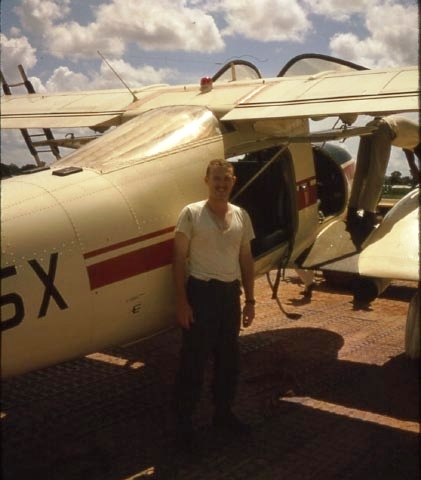 Unlike my fighter brethren, our job usually required that we weren't seen- they call that Special Ops now. The closest I came to not making it back was when we got lost over the PDJ and were running on fumes by the time we made it back to Thailand. A certain '65 graduate is still convinced I tried to do him in on that mission. I tacked on a few missions throwing pamphlets out of aircraft (O-1s??) in the Nha Trang area while stuck on Command Post Duty. One of my strongest, but not fondest, memories is “celebrating” my first wedding anniversary in Nakhon Phanom Thailand by letting the Base Chaplain buy me a drink at the bar. What special wives we had to put up with these things.
Unlike my fighter brethren, our job usually required that we weren't seen- they call that Special Ops now. The closest I came to not making it back was when we got lost over the PDJ and were running on fumes by the time we made it back to Thailand. A certain '65 graduate is still convinced I tried to do him in on that mission. I tacked on a few missions throwing pamphlets out of aircraft (O-1s??) in the Nha Trang area while stuck on Command Post Duty. One of my strongest, but not fondest, memories is “celebrating” my first wedding anniversary in Nakhon Phanom Thailand by letting the Base Chaplain buy me a drink at the bar. What special wives we had to put up with these things.
Returning from SEA found us on the way to Patrick AFB flying H3s in support of launches out of Cape Kennedy. One thing I will never forget is the vibration of a Saturn V in a helicopter airborne 5 miles away. We also put in some hardship time supporting launch tracking sites in the Bahamas – strip off the flight suit and go swimming while our passengers did whatever they did. During this time an old professor from the Astronautics Department at USAFA flew down to Patrick and interviewed me for a faculty position. We both decided it was a good fit and that I should get my Masters from MIT enroute.
At this point the Air Force decided that those of us who learned to fly in T-28s and helicopters weren't “real” pilots and said we had to go back to Randolph AFB to go through T-38 training. MIT had to wait while Glenn Coleman and I started another “new” program at Randolph for retreads (or some other terms) called R Flight. Since most of us had already had one Viet Nam tour the instructors weren't quite sure what to do with us, so we did get a lot of solo time. We were all supposed to go to a real fixed wing flying assignment which I think everyone but me did. Since USAFA wanted me to go to grad school ASAP I was allowed to check out in T-39s at Randolph in the old Instrument Pilot Instructor School (IPIS) and then maintained currency in them out of Hanscom Field while attending MIT. These were interesting times in Cambridge during 69 and 70 with anti war protestors blocking access and threatening to burn down ROTC buildings. Nevertheless I completed my MS and headed to USAFA in July 1970. Finally we would start settling down.
USAFA Teaching Days
The ten years of teaching at USAFA in the Astronautics Department (1970-1980)included two years at UCLA to get my Ph.D. in “Dynamic Systems Control” as well as another year in SEA. The latter was my graduation gift from the Air Force for completing my UCLA studies. In addition to the usual entry level courses a “new guy” gets to teach I focused on inertial navigation systems during my first two years while being an IP in the T-29 navigation trainer. We adopted our oldest daughter Melissa during this time and she was a joy.My second SEA tour started April 1976 in HH53s with the 40th Air Rescue and Recovery Squadron. The 40th returned from evacuating Saigon the day before I arrived so there was not a lot of action except for the Mayeguez “Incident” which I experienced on the ground, not yet having completed a local area checkout. We moved through Thailand as various bases were closed, but even as we totally shut down Thailand the AF determined I had not yet flown enough so I had another 4 months in Kadena AB tacked on to the Thailand tour.
The last four years at USAFA I taught more guidance and control courses. We were part of the early GPS studies and had a role in developing the AC130 gunship. My life goal had been to be an astronaut and I was fortunate to be able to interview with NASA in Houston as part of the final selection process but obviously didn't make the cut. One who did had gone through helicopter training with me- a guy named Fred Gregory. He made quite a name for chopper pilots in NASA. Right after not being selected for astronaut training the AF also decided I wasn't up to their standards for Lt. Col. Selection so this was a stressful time. About this time we had our first natural-born daughter Kathleen so there was good with the bad. My acting department head, Tom Eller (class of '61) went well beyond the call of duty to get me positioned for the next promotion board and was successful. Thanks Tom.
Finishing the Air Force
In 1980 I went on loan to the FAA and became their branch chief for human factors development. I was able to keep flying the T-39 and all in all had a good time on the Mall in Washington DC. After two years in civilian clothes I was re-blued and joined AF Systems Command at Andrews AFB as a Division Chief and then as Director of Mission Analysis and Long Range Planning. I worked with and for some very good people over those two years. I kept flying the T-39 most of that time. Even though my boss was working hard to get me “caught up” in the promotion race I decided the time was right to start a second career. My son Michael was born in 1981 so I retired with a couple of preschoolers. It kept us young.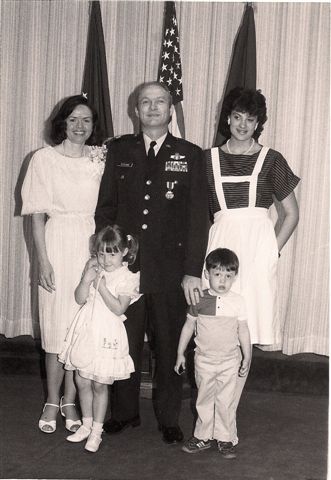
GE Aerospace
I had really enjoyed the analysis and technology planning of my last AF tour so when a chance came to help GE Aerospace in Valley Forge do the same thing I jumped at the chance. For two years I was like a kid in a candy store, being paid to travel around the country scouting for technology which GE might use in the next 20 years. During that time I was able to help Dr. Al Preyss join us on the GE staff- the same Dr. (then Major) Preyss who had interviewed me at Patrick AFB for a USAFA teaching job. I was honored to work with him. I got my introduction to classified programs at GE and was program manager for some very interesting technology developments. When GE won the contract as the System Engineer and Integrator for the ballistic missile defense program I was able to return to Colorado Springs to head up the office responsible to integrate missile defense with NORAD and other US Space Command programs. It was good to be “home” in Colorado again, for what will be our last time, arriving in 1988. I stayed with the program for about 5 years but departed during the acquisition of GE Aerospace by Martin Marietta.Bouncing Around
My oldest daughter died in an accident the day I left GE so I really didn't do anything for about six months except be with my family. In 1994 I had my first exposure to the world of the entrepreneur. I partnered with someone who had started and grown multiple companies through their Initial Public Offering (IPO). I learned a lot during this time about financing of young companies, how to place a value on them and how to find good strategic partners. Unfortunately we were unsuccessful in our early focus to convince defense companies to apply their significant technology portfolios in the commercial market. Something about needing a different culture and mind set. Finding a need for revenue I left this partnership in 1998 and spent several years as a Systems Engineer and Program Manager with several companies. There were some interesting programs, including preparing for Y2K effects on embedded computer systems, implementing a computer capability through cable TV (about 10 years too early), developing a new generation data recording system and finally developing GPS based systems to enhance smart bomb accuracy. I had not intended to retire, but when I voluntarily left my last position in 2006 it appeared that I had.Helping Baby Companies Grow Up
When I realized I was retired, I did what lots of folks have done- I started my own company. My intent was to help nonprofit companies be more effective in accomplishing their missions by doing a better job at their project selection and management. Trying to convince organizations to think differently soon became discouraging. In 2007 I was attracted to the Colorado Springs Technology Incubator, a nonprofit organization which helps early stage technology based companies reach their potential, by a new dynamic incubator President who was much aligned with what I knew would be successful. Those years of bouncing around had taught me a lot about what works and doesn't work when starting a new company. Over three years later I am still there and I believe we have helped some people on their way to having a successful company. Since my last Air Force assignment my primary interest has been in helping technology move from laboratories to the market place. At CSTI I have a chance to do this and may be able to focus even more in this area over the next few years. It is exciting to see what technologies are being developed in Federal Laboratories and University Labs and even more exciting to help match these with young companies who can use those technologies.Beyond Work
So what do I do with the rest of my time? Back even before USAFA I enjoyed singing and was in the USAFA Chorale as well as many church singing groups since then. I actually met my wife through singing- she in the Colorado Womans College and me in the chorale. We have done a lot of singing together and “acting” in plays like Fiddler on the Roof. We have been active for nearly 30 years in small groups of couples from our churches through the years. I also spent nearly 10 years on the Board of the Colorado Springs Christian Schools, where all three of our kids graduated. I always enjoyed sports cars and still compete occasionally in autocrosses with the Sports Car Club of America (SCCA) in my latest fun car--a Nissan 350Z.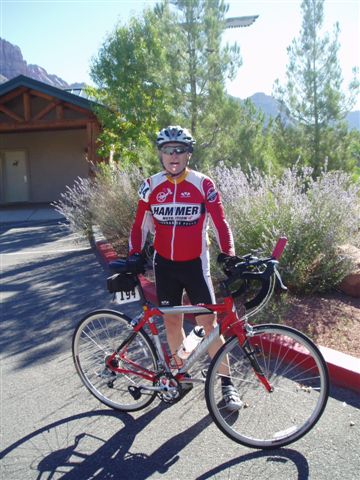
Most of my spare time for the last 15 years plus has been riding my bike- a real bike powered by me, not a motor. I have been averaging about 4000 miles a year recently and started competing in senior games when I turned 65. I figured I would never be any younger. I have been slowed some by two replaced hips and a rebuilt knee, but other than setting off all the airport alarms I can't tell much difference.
It's Not Over Yet
[ Home ] [ Table Of Contents ]